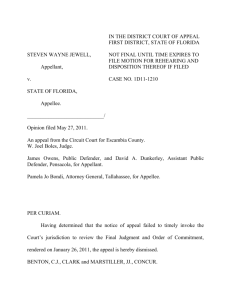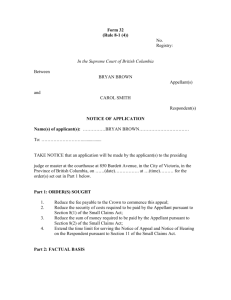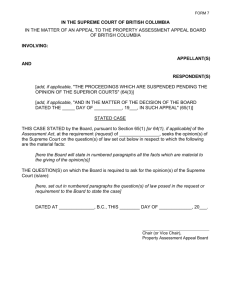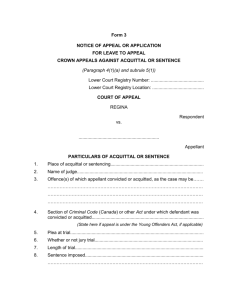Child Support Applications - Federal Circuit Court of Australia
advertisement
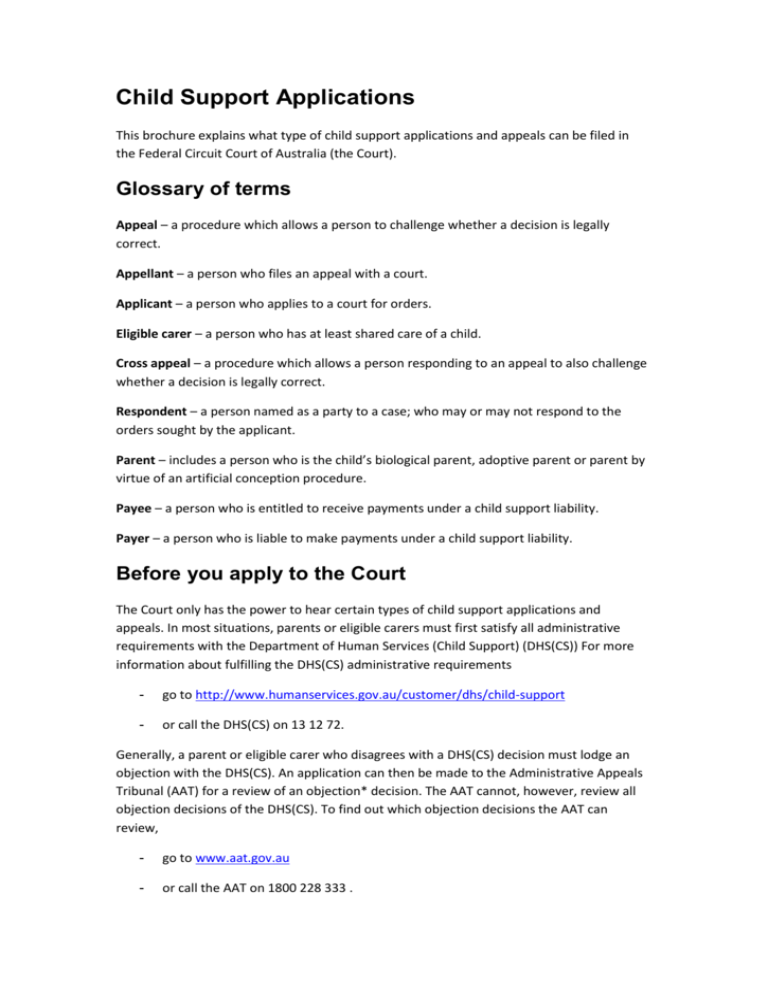
Child Support Applications This brochure explains what type of child support applications and appeals can be filed in the Federal Circuit Court of Australia (the Court). Glossary of terms Appeal – a procedure which allows a person to challenge whether a decision is legally correct. Appellant – a person who files an appeal with a court. Applicant – a person who applies to a court for orders. Eligible carer – a person who has at least shared care of a child. Cross appeal – a procedure which allows a person responding to an appeal to also challenge whether a decision is legally correct. Respondent – a person named as a party to a case; who may or may not respond to the orders sought by the applicant. Parent – includes a person who is the child’s biological parent, adoptive parent or parent by virtue of an artificial conception procedure. Payee – a person who is entitled to receive payments under a child support liability. Payer – a person who is liable to make payments under a child support liability. Before you apply to the Court The Court only has the power to hear certain types of child support applications and appeals. In most situations, parents or eligible carers must first satisfy all administrative requirements with the Department of Human Services (Child Support) (DHS(CS)) For more information about fulfilling the DHS(CS) administrative requirements - go to http://www.humanservices.gov.au/customer/dhs/child-support - or call the DHS(CS) on 13 12 72. Generally, a parent or eligible carer who disagrees with a DHS(CS) decision must lodge an objection with the DHS(CS). An application can then be made to the Administrative Appeals Tribunal (AAT) for a review of an objection* decision. The AAT cannot, however, review all objection decisions of the DHS(CS). To find out which objection decisions the AAT can review, - go to www.aat.gov.au - or call the AAT on 1800 228 333 . Where the AAT cannot review an objection decision, parents or eligible carers may be able to apply to the Court for orders. * Before applying to the AAT for a review, the parent or eligible carer must lodge an objection to the decision with the DHS(CS) and wait to receive a response from the DHS(CS). Legal advice You should seek legal advice before deciding what to do. A lawyer can help you understand your legal rights and responsibilities, and explain how the law applies to your case. A lawyer can also help you reach an agreement with the other party without going to court. You can seek legal advice from a: - legal aid office - community legal centre, or - private law firm. Court staff can help you with questions about court forms and the court process, but cannot give you legal advice. Applications The Court can hear: - an application for a declaration that a person is or is not a parent of a child for the purposes of paying or not paying child support - an application for recovery of child support paid when a person is not liable to pay child support - an application for leave to depart from an administrative assessment for a period over 18 months but less than seven years ago - an application for child support to be paid in a form other than periodic amounts (or an application to discharge, suspend, revive or vary a previous court order about child support) - an application to discharge, suspend, revive or vary a child support agreement; or if consent was obtained by fraud or undue influence, an application to set aside a child support agreement - an urgent application for the payment of child support - an application for a stay order, which is a temporary order that suspends or reduces the payment of child support until a final order is made. From 1 July 2008, stay orders can address a specific collection action of the DHS(CS). For example, a stay order could: o order the DHS(CS)to cease collecting from a payer's salary; o order the DHS(CS)to withdraw or modify a garnishment notice; o order the DHS(CS)not to collect a payer's taxation refund; o order the DHS(CS)not to disburse monies held to the payee; or o order the DHS(CS)to cease any and all administrative collection. - an application about child maintenance or overseas child maintenance orders - an application to recover a child support debt by the Child Support Registrar or payee - an application by the Child Support Registrar to set aside a transaction (or restrain a person from entering into a transaction) to reduce or defeat a maintenance liability. Applying to the Court To start a case, a person (the applicant) must file an application form with the Court. In support of the application, the applicant must also file: (a) an affidavit setting out the facts and circumstances relied on and the grounds of the application, attaching: (i) a copy of any assessment made by the Child Support Registrar relevant to the application (ii) a copy of any decision made by the Child Support Registrar or AAT relevant to the application and statement of reasons for that decision, and (iii) a copy of any orders relevant to the application. (b) a completed financial statement or affidavit of financial affairs. If the case relates to a child support agreement, the applicant must register a copy of the agreement with the Court by attaching a copy of the agreement to an affidavit. Time limits The applicant must file an application for a paternity declaration or non-paternity declaration within 56 days of the day the Child Support Registrar’s decision. Note: The Court may extend the time limit. Service Service is the process of sending or giving court documents to a party after they have been filed with the Court. The applicant must arrange to serve: (a) the respondent (b) a parent or eligible carer of the child, and (c) the Child Support Registrar. In most situations, an application must be served at least 28 days before the hearing date. The applicant must serve any further documents on which he or she intends to rely on each party to the proceedings at least 21 days before the hearing date. Note: A copy of this brochure must also be served on the respondent. Responding to an application A respondent to an application must file a response. A response must be filed and served within 14 days of service of the application. A response may: (a) indicate consent to an order sought by the applicant (b) ask the Court to make another order (c) ask the Court to dismiss the application or appeal (d) seek orders in a matter other than the matter set out in the application, or (e) make a cross-claim against the applicant, or another party. The respondent must also file an affidavit stating the facts relied on. Where the application relates to financial matters, the respondent must also file a completed financial statement or affidavit of financial affairs. Evidence In all applications, apart from paternity cases, each party (other than the Child Support Registrar) must bring the following documents to the first and all subsequent hearing dates: (a) a copy of the party’s taxation return for the three most recent financial years (b) the party’s taxation assessment for the three most recent financial years (c) the party’s bank records for the period of three years ending on the date when the application was filed (d) if the party receives wage or salary payments; the party’s payslips for the past four pay periods (e) if the party owns or controls a business; the business activity statements and the financial statements and accounts (including profit and loss statements and balance sheets) for the business for the three most recent financial years (f) any other document relevant to determining the income, needs and financial resources of the party. Note: – Documents that may need to be produced under paragraph (f) include documents setting out the details mentioned in rule 24.03 of the Federal Circuit Court Rules 2001. Before the hearing date, a party must produce the documents outlined in paragraphs (a) to (f) for inspection, if the other party to the case makes a written request for their production. If a request is made, the document must be produced within three working days of the request being received. Rule 24.03 - Full and frank disclosure (1) A party required under this Part to file a financial statement or affidavit of financial circumstances must make in the statement or affidavit a full and frank disclosure of his or her financial circumstances, including details of: (a) any vested or contingent interest in property (including real or personal property, superannuation and legal and equitable interests); and (b) income from all sources, including any benefit received in relation to, or in connection with, the party’s employment or business interests; and (c) the party’s other financial resources; and (d) any trust: (i) of which the party is, or has been since the separation of the parties, the appointor or trustee; or (ii) of which the party, or the party’s child, spouse or de facto spouse is, or has been since the separation of the parties, an eligible beneficiary as to capital or income; or (iii) of which a corporation is an eligible beneficiary as to capital or income if the party, or the party’s child, spouse or de facto spouse is, or has been since the separation of the parties, a shareholder or director of the corporation; or (iv) over which the party has, or has had since the separation of the parties, any direct or indirect power or control; or (v) of which the party has, or has had since the separation of the parties, the direct or indirect power to remove or appoint a trustee; or (vi) of which the party has, or has had since the separation of the parties, the power (whether subject to the concurrence of another person or not) to amend the terms; or (vii) of which the party has, or has had since the separation of the parties, the power to disapprove a proposed amendment of the terms or the appointment or removal of a trustee; or (viii) over which a corporation has, or has had since the separation of the parties, a power mentioned in subparagraphs (iv) to (vii), if the party is a director or shareholder of the corporation; and (e) any gift or other disposition of property made by the party since the separation of the parties; and (f) if there is a partnership, trust or company (except a public company) in which the party has an interest, copies of the 3 most recent financial statements and the last 4 business activity statements lodged by the partnership, trust or company. Appeals The Court can hear: - an appeal from a decision of the Administrative Appeals Tribunal (AAT) in a child support first review, and - an appeal from a decision of the Child Support Registrar to issue a departure prohibition order. A party to a proceeding before the AAT may appeal to the Court against a decision of the AAT on a question of law*. The AAT may also refer a question of law arising from the proceedings to the Court. * Question of law – an issue arising from a case about how the law was applied or not applied to the facts of a case or about whether the process was legally adequate. A delegate of the Child Support Registrar may make an order, known as a departure prohibition order, stopping a person from leaving Australia. A person aggrieved by the making of a departure prohibition order may appeal to the Court against the making of the order. Filing an appeal with the Court To appeal a decision made by the AAT, a person (the appellant) must file a Notice of Appeal (Child Support) form. The appellant must file this form in a General Federal Law Registry; as these appeals can only be heard by the Federal Circuit Court and the Federal Court. To appeal a decision made by Child Support Registrar to issue a departure prohibition order, the appellant must file a Notice of Appeal (Child Support) form. The appellant must file this form in a Federal Court Registry; as these appeals can only be heard by the Federal Circuit Court and the Federal Court. A copy of the AAT or Child Support Registrar’s decision must be attached to the appeal form, along with the statement of reasons for the decision being appealed. The AAT’s decision will usually include the statement of reasons. The appellant may also file a completed financial statement and any affidavits that are to be relied on in the appeal. However, further evidence will not normally be admitted on the hearing of an appeal. If the appellant wishes to rely on further evidence, they must indicate this on the Notice of Appeal and file an affidavit setting out the additional evidence that is to be relied on. Time limits The appellant must file an appeal from a decision of the AAT within 28 days of receiving a written statement of reasons for the decision. An appellant can ask the court to extend the time limit. Service The appellant must arrange to serve: (a) the respondent (b) a parent or eligible carer of the child (c) the Child Support Registrar, and (d) the AAT* (if it is an appeal from the AAT). * The appellant must serve a notice of appeal from a decision of the AAT on the AAT within seven days of the day of filing the appeal with the Court. The appellant must serve any further documents on which he or she intends to rely on all parties to the proceedings at least 21 days before the hearing date. Note: A copy of this brochure must also be served on the respondent. Responding to an appeal A respondent to an appeal may file a cross-appeal. The cross-appeal form is the same as the Notice of Appeal (Child Support) with the addition of the word ‘Cross’ inserted before ‘Appeal’; for instance, Notice of Cross-Appeal (Child Support). The respondent must serve a copy of the notice on each party to the proceedings within 21 days after service of the Notice of Appeal. Note: If a response is not filed, the respondent must file a Notice of Address for Service. The Court hearing All parties must attend the court hearing and bring all relevant documents with them. Sometimes a party (or witness) may appear via video or telephone. This needs to be arranged with the Court prior to the hearing. How the hearing is conducted may vary depending on the type of application or appeal, the issues in dispute and the complexity of the case. In some court locations, child support applications and appeals can often be heard and determined on the first court date. It is advisable to check if any special procedures or requirements apply in the location where your application or appeal is listed. Legislation Depending on the circumstances of the case, the Court may consider the following Acts and Rules: - Administrative Appeals Tribunal Act 1975 - Child Support (Assessment) Act 1989 - Child Support (Registration and Collection) Act 1988 - Family Law Act 1975 - Federal Circuit Court Rules 2001 The Acts and Rules are regularly updated, so it is important to obtain a copy of the most recent edition. Another useful legal resource is the Child Support ‘Guide’ which is available at http://www.humanservices.gov.au/customer/dhs/child-support . The Guide sets out the Child Support Policy and view of the child support scheme and its administration. More information For more information, including access to the Act, Rules and any of the forms or publications mentioned in this brochure go to www.federalcircuitcourt.gov.au or contact the court registry. Approved by the Chief Judge pursuant to subrule 25A.07(5) of the Federal Circuit Court Rules 2001. This brochure provides general information only and is not provided as legal advice. If you have a legal issue, you should contact a lawyer before making a decision about what to do or applying to the Court. The Federal Circuit Court cannot provide legal advice. FEDERAL CIRCUIT COURT OF AUSTRALIA BRCSFCC_0715 V1

